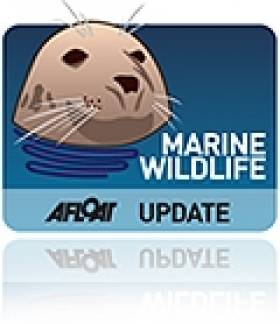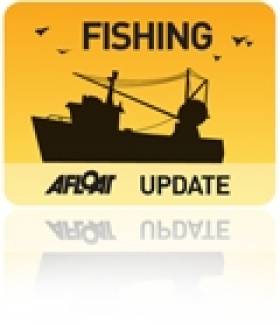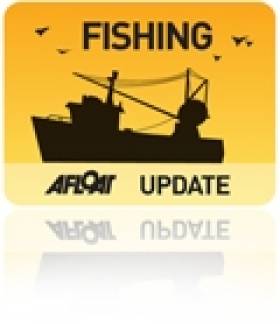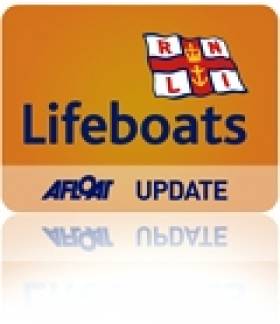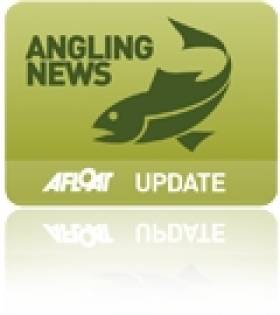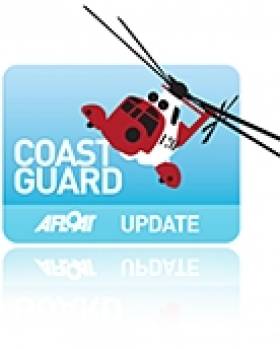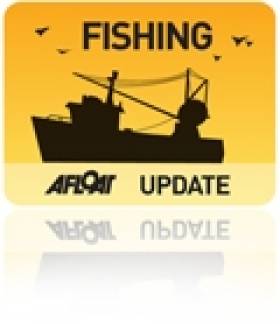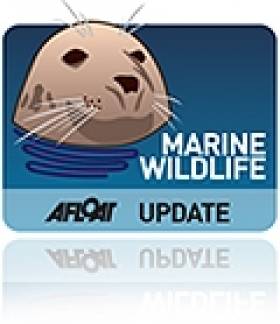Displaying items by tag: Fishing
Shark Attack in English Channel Captured on Video
#SHARK ATTACK - The UK Sun has posted a dramatic video of the moment when two anglers in the English Channel were attacked by sharks.
Graeme Pullen and Wayne Comben had been fishing for Mako sharks to tag and release off Falmouth in Cornwall, as part of a marine wildlife conservation programme, when their 17-foot boat was suddenly surrounded by a school of blue sharks.
The three sharks were described by Pullen as being in a "frenzied state" during the three-minute assault.
“Normally they would hold back and wait to see if there was any food drifting free but these were very aggressive and just charged directly at the boat," he said.
“One of them came out of the water and launched an all-out attack on the bag of fish, biting and tearing it to pieces — it was very worrying to witness."
Pullen concurred with experts' belief that such sharks are coming closer to land to hunt as overfishing in the Atlantic has all but wiped out their food supply.
New RnaG Radio Series on Galway Bay Fishing Industry
#FISHING - A new radio series on developments in Galway's fishing industry is part of the new autumn schedule on Raidió na Gaeltachta.
As the Galway Advertiser reports, Ballach, Bradán agus Bairneach is funded through the Broadcasting Authority of Ireland's Sound and Vision scheme and will cover the changes experienced in fishing in Galway Bay from Famine times till the present day.
Topics to be covered on the seven-part series, presented by former RnaG station head Tomás Mac Con Iomaire, include traditional fishing methods and classic fishing boats, the establishment of Bord Iascaigh Mhara (BIM), the effects of European fisheries policy, and contemporary developments such as fish farming that have prompted some recent controversy.
Ballach, Bradán agus Bairneach will be broadcast Saturdays at 6.30 pm, with the first programme tonight 15 September focusing on fishing in olden times and the folklore surrounding it. Link to the show here.
BIM Decries 'Scare Tactics', Urges Support for Fish Farming
#FISHING - Bord Iascaigh Mhara (BIM) has called on environmental campaigners opposed to changes in the current fish farm licensing system to "get behind Ireland's aquaculture industry".
In a letter to The Irish Times yesterday, the fisheries board wrote in response to Tony Lowes of Friends of the Irish Environment, whose own letter to the paper on Tuesday lambasted the IFA's claims of an "inexplicable delay" in the State's processing of licence applications for new fish farms off the west coast.
BIM chief executive Jason Whooley said it was "refreshing" to read Lowes "expressing confidence in and support for the current Irish aquaculture licensing system", which is "both rigorous and science-based... involves a high level of public consultation and is fully transparent."
However, Whooley hit out at what he described as Lowes' "scare tactics" and "spurious" attempts "to mislead by comparing the output from a salmon farm with human sewage".
Lowes had written that salmon farming "is a highly polluting industry", and that discharge of nitrogen and phosphorous from aquaculture facilities "can fuel toxic algae blooms, which have cost the shellfish industry dear".
Whooley countered that argument, stating that "the harmful elements from human sewage, such as E.coli, cryptosporidium or viruses, are simply not present in the excretions from cold-blooded creatures, such as the Atlantic salmon."
He also urged Lowes to "get behind Ireland’s aquaculture industry and support it as a sustainable and valuable source", adding that "increasing the output of farmed Irish organic-certified salmon represents a great opportunity to create a large number of sustainable jobs in Ireland’s coastal communities."
Fish Farm Delays Not 'Inexplicable' Say Environmental Campaigners
#FISHING - Environmental campaigners have lambasted the IFA's claims of an "inexplicable delay" in the State's processing of licence applications for fish farms.
In a letter to The Irish Times yesterday, Tony Lowes of Friends of the Irish Environment says that the delay – to allow for proper environmental studies to be conducted – "has been explained again and again" by Minister for the Marine Simon Coveney.
He was responding to a letter last Friday by Richie Flynn of IFA Aquaculture, who highlighted the "suffering" of coastal communities as a result of processes that "hamper development and delay investment in the hundreds of companies involved in farming salmon, oysters, mussels, trout and other species".
Lowes writes in counter that salmon farming "is a highly polluting industry", and that discharge of nitrogen and phosphorous from aquaculture facilities "can fuel toxic algae blooms, which have cost the shellfish industry dear".
He claims that the proposed salmon farm in Bantry Bay in West Cork would have a nitrogen and phosphorous discharge "equivalent to the sewage of a town 10 times the size of Bantry".
Lowes also alleges that the deep-sea "super salmon" farm in Galway Bay - the licence application for which is undergoing statutory consultation till 2 October - would produce the equivalent effluent of a city more than double the size of Galway.
In addition, he makes reference to the threat to native salmon in Irish rivers through sea lice infestations.
"The EU habitats directive requires baseline studies and environmental impact statements," writes Lowes. "Licensees can be granted only if the project will not have adverse impacts on protected species and habitats."
#FISHING - Bord Iascaigh Mhara (BIM) recently convened a Fisheries Local Action Group (FLAG) with representatuves from the fishing and tourism industries, community groups and county councils to discuss ways to boost revenue in the Galway and Clare region.
As the Galway Advertiser reports, the Western region FLAG comes after the official launch of the 'Axis 4' programme for sustainable development of fishery-dependent areas, which aims to empower communities that rely on fishing or aquaculture to further develop the marine resources at their disposal.
It also comes hot on the heels of the Government's 'ocean wealth roadmap' launched by Marine Minister Simon Coveney earlier this month, which is specifically geared towards exploiting Ireland's potential for 'blue growth'.
The six FLAGs established in key coastal areas around Ireland are responsible for formulating a development strategy for funding suitable local projects. To qualify for funding support, such projects must satisfy a list of critera, such as having a clear marine connection or providing specific benefit to a fishing area.
The Galway Advertiser has much more on the story HERE.
Body Recovered After Sailing Dinghy Overturns Off West Cork
#MISSING BOATS - The Irish Times reports that the body of a man in his 60s has been recovered from the sea off West Cork in the early hours of this morning.
The body, believed to be that of John O'Leary from Allihies, was found as part of a major search operation after the sailing dinghy carrying the man and his 18-year-old son Christopher overturned off the Beara Peninsula yesterday evening.
According to RTÉ News, the two spent four hours clinging to the boat before swimming towards the shore. Christopher reached land almost 1km away to raise the alarm but his father went missing in the interim.
The boat was discovered around 8pm with no sign of John O'Leary in the vicinity, according to the Irish Independent.
The Irish Coast Guard at Valentia co-ordinated the search operation from 9pm last night, and volunteers with the Castletownbere RNLI lifeboat recovered a body off Cod's Head around 1.30am. A postmortem will be carried out later today at Cork University Hospital.
Meanwhile, the search continues for a missing fishing boat off Co Clare.
The Lady Eileen, with two crew on board, was due to return to Quilty yesterday evening.
Coastguard search teams discovered debris and diesel in the water near Spanish Point before the search was postponed due to low light.
Garda divers have been asked to assist in the search and are due in the area around midday.
Dublin Tackle Shop Undertakes National Bass Survey
#ANGLING - Henry's Tackle Shop in Ballybough is conducting a countrywide survey to determine the extent of the decline of bass activity around Ireland's coastline.
According to the shop's Henry Lynam and Pat Daly, the last two years have seen some unusually low bass activity on many coasts.
As part of their national survey, they are asking anglers to return log book pages to measure the quality of the bass fishing across Ireland this year.
"Bass are a species protected by by-laws," they wrote on their blog. "The quality of protection afforded by these laws has varied but have mainly been sufficient to help the stock recover from a serious crash in the 1980s to a reasonable level over many years.
"We fear now that with the double edged sword of financial stress increasing the number of poachers and decreasing budget for fisheries protection that perhaps bass are coming under pressure again."
Other factors they note include the year's weather extremes and the large and the unusual northward movement of local plankton.
"Whatever the cause we can only observe and record the resulting facts for presentation to someone who is in a position to act."
The warning comes as calls are being made to reopen Ireland's bass fisheries for commercial fishing. Anglers are asked to return their bass angling log book pages at the end of the bass fishing season to Henry's Tackle Shop, 19 Ballybough Road, Dublin 3.
Fisherman Airlifted from French Trawler Off West Cork
#COASTGUARD - A crewman on a French trawler off West Cork has been airlifted to hospital by coastguard helicopter, as RTÉ News reports.
The fisherman is understood to have suffered head injuries on the fishing vessel some 240km off the Beara Peninsula in the early hours of this morning Tuesday 7 August.
The Irish Coast Guard's Valentia unit co-ordinated the airlift, dispatching the Shannon rescue helicopter to the trawler. The injured man was winched on board and taken to Cork University Hospital. His current condition is not yet known.
Giant Bluefin Tuna Caught Off Kerry, Cork Coasts
#FISHING - Dingle fishermen trawling for tuna off the south-west coast of Ireland found a big surprise in their nets this week in the form of an enormous 2-metre-long bluefin.
As The Irish Times reports, the Atlantic bluefin is considered one of the big game fish and is highly sought-after for top-quality sushi, a demand that has led to its adding to the endangered species list.
Strict quotas have been placed on bluefin for fishermen who normally trawl for albacore tuna - but the Dingle boats Fiona K and the Atlantic Venture were lucky that their unexpected catch was within the 1% they are allowed each year.
The 140kg tuna is set to end up in shops and restaurants in Dingle and throughout Kerry for much less than one would pay for such fish in Japan, where a bluefin double the size went for over €600,000 earlier this year.
Meanwhile, an even bigger bluefin was snappped up by eager fish lovers at Limerick's Milk Market last weekend.
The 250kg goliath was caught 600 miles off Castletownbere in Co Cork by local fisherman JD Sullivan, according to the Limerick Leader.
“The tuna migrate up the west coast of Ireland around this time of year, but very few of them are caught,” said Paul Cusack of Rene Cusack’s fish shop in the market.
It's leading some to question if there's something in the water, with news from Angling Times of a giant 189lb common skate recently caught off the coast of Northern Ireland.
Algal Bloom Killing Fish, Shellfish Off West Coast
#MARINE WILDLIFE - An algal bloom off the west coast of Ireland is responsible for significant fish and shellfish kills from Galway to Donegal, according to the Marine Institute.
As The Irish Times reports, as much as 80% of stocks have been affected on Donegal oyster farms, and the bloom is also impacting negatively on angling tourism in the west and northwest.
The algae responsible, karenia mikimotai, occurs naturally in Ireland's coastal waters during the summer months and his harmless to humans, but contains a "toxic irritant" that damages the gills of fish, shellfish and other marine species.
Low-level samples were first detected in May but in the last two weeks it has grown into a dense bloom from Donegal to Mayo, with high levels now being recorded in Galway Bay, according to the Marine Institute's Joe Silke.
"In Donegal the bloom was so dense that there were many reports of discoloured red or brown water in some areas and several areas have reported dead marine life washing up on the shoreline, requiring local authorities to close certain beaches,” he said.
"The bloom affects species that live on or near the sea bed so we are seeing flatfish, lugworms and some shellfish getting washed up on the beaches."
The image evokes memories of the notorious 'red tide' that killed wild fish and shellfish along the west coast in 2005.
Meanwhile, the Marine Insitute said there are "some indications" that the bloom may be moving back out to sea, as observed in the latest satellite images and modelling data.
"However, cell counts of samples analysed in the Marine Institute... show that the bloom is still of the same density in the Donegal and Sligo regions as it was last week."



























